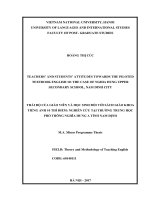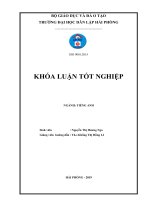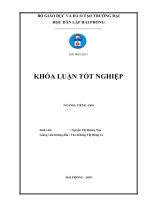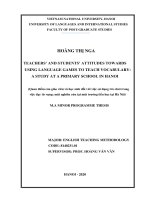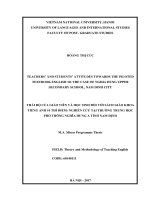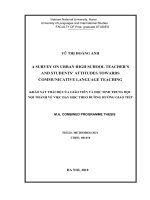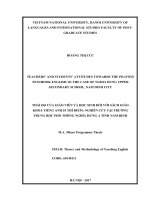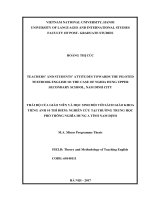a study on teachers and students attitudes towards the cultural content in the international commercial textbook for non english majors at haiphong private university
Bạn đang xem bản rút gọn của tài liệu. Xem và tải ngay bản đầy đủ của tài liệu tại đây (1.18 MB, 79 trang )
VIETNAM NATIONAL UNIVERSITY, HANOI
UNIVERSITY OF LANGUAGES AND INTERNATIONAL STUDIES
DEPARTMENT OF POST-GRADUATE STUDIES
*** ***
NGUYỄN THỊ TỐ HOÀN
A STUDY ON TEACHERS’ AND STUDENTS’ ATTITUDES
TOWARDS THE CULTURAL CONTENT IN THE
INTERNATIONAL COMMERCIAL TEXTBOOK FOR NONENGLISH MAJORS AT HAIPHONG PRIVATE UNIVERSITY
(Nghiên cứu thái độ của giáo viên và sinh viên đối với nội dung văn hóa
trong giáo trình quốc tế dành cho sinh viên không chuyên Anh trường
Đại học Dân lập Hải Phòng )
M.A. MINOR PROGRAMME THESIS
Field: English Teaching Methodology
Code: 60140111
Hanoi, 2014
VIETNAM NATIONAL UNIVERSITY, HANOI
UNIVERSITY OF LANGUAGES AND INTERNATIONAL STUDIES
DEPARTMENT OF POST-GRADUATE STUDIES
*** ***
NGUYỄN THỊ TỐ HOÀN
A STUDY ON TEACHERS’ AND STUDENTS’ ATTITUDES
TOWARDS THE CULTURAL CONTENT IN THE
INTERNATIONAL COMMERCIAL TEXTBOOK FOR NONENGLISH MAJORS AT HAIPHONG PRIVATE UNIVERSITY
(Nghiên cứu thái độ của giáo viên và sinh viên đối với nội dung văn hóa
trong giáo trình quốc tế dành cho sinh viên không chuyên Anh trường
Đại học Dân lập Hải Phòng )
M.A. MINOR PROGRAMME THESIS
Field: English Teaching Methodology
Code: 60140111
Supervisor: Dr. Le Van Canh
Hanoi, 2014
DECLARATION
To the best of my knowledge and belief, this minor thesis contains no
material which has previously been submitted and accepted for any other degree in
any university. The thesis is my own work and based on my own research. It
involves no material previously published or written by any other person, except
where due reference is acknowledged in the paper.
Hanoi, 2014
Nguyễn Thi Tố
̣ Hoàn
ABSTRACT
The study investigates the cultural content of the textbook Solutions Preintermediate Students’ Book and the attitudes of students and teachers towards that
content. The analysis of the cultural content was based on two criteria – one of
Cortazzi and Jin (1999) and the other of Byram (1989). Survey questionnaire and
interview were used to collect information from students and teachers. Via the data,
convergences and divergences between students‟ and teachers‟ attitudes were drawn.
The findings showed that Solutions Pre-intermediate Students’ Book was the
textbook on target culture with the British and American culture dominantly
presented. All the teachers and most of the students expressed positive attitudes
towards the cultural content of the book although there were a number of students
saying no to culture learning. However, the teachers‟ teaching of cultures did not
meet the students‟ need. The results suggested that some negative attitudes of
students need to be recognized and changed as soon as possible. Moreover, the
university authority needs take more consideration in choosing an international
commercial book to be a textbook. They also need undertake an investigation into
the effectiveness of the new learning and teaching method being applied, which
prevented teachers from satisfying students‟ need, with the teachers‟ and students‟
voice involved. It is hoped that these findings provide useful criteria for an
expanding discussion of cultural issues in ELT.
ACKNOWLEDGEMENTS
I owe a debt of gratitude to those who has helped me complete the study.
First and foremost, I am sincerely grateful to my supervisor, Doctor Lê Văn Canh,
for his guidance, encouragement and endless support from the early stages to this
day.
A special thank of mine goes to the teachers and students at Hai Phong
Private University who spent time helping me with data collection and gave me
encouragement.
I also would like to give my genuine thanks to my colleagues who
appreciated me for my work and motivated me.
Finally, I would like to thank my family for their warm support and constant
encouragement that gave me strength to go through the study process.
LIST OF ABBREVIATIONS
EFL: English as a Foreign Language
ELT: English Language Teaching
ESL: English as a Second Language
LIST OF CHARTS
Chart 1.How important of culture in English learning............................................. 27
Chart 2.Culture Learning Preferences ...................................................................... 28
LIST OF TABLES
Table 1 Cortazzi and Jin (1999)‟s classification ....................................................... 25
Table 2 Teachers‟ ways of teaching cultural content of the book ............................ 29
Table 3 What students like about their teacher‟s culture teaching ........................... 30
Table 4 What students would like to change about their teachers‟ culture teaching 31
TABLE OF CONTENTS
PART A: INTRODUCTION ................................................................................. 01
1. Statement of the problem and rationale for the study......................................... 01
2. Aims of the study ................................................................................................ 03
3. Significance of the study .................................................................................... 04
4. Scope of the study............................................................................................... 04
5. Research questions ............................................................................................. 04
6. Methods of the study .......................................................................................... 05
7. Organization of the study.................................................................................... 05
PART B: DEVELOPMENT .................................................................................. 06
Chapter 1: Literature review .................................................................................... 06
1.1. Overview of culture and language .................................................................... 06
1.1.1. The relationship between culture and language ....................................... 07
1.1.2. The role of culture in ELT ........................................................................ 07
1.1.3. Perspectives on culture learning and teaching
from intercultural competence perspectives ....................................................... 9
1.2. Overview of cultural content in the textbook................................................... 12
1.2.1. Role of textbooks in ELT .......................................................................... 12
1.2.1. Cultural content in the textbook ............................................................... 14
1.2.3. Analysis of cultural contents in the textbook ........................................... 15
1.3. Studies on teachers‟ and learners‟ attitudes ....................................................... 16
1.3.1. Definitions of attitude ............................................................................... 16
1.3.2. The roles of learners' and teachers' attitudes
in learning and teaching cultures ........................................................................ 17
1.3.3. Previous studies on teachers‟ and learners attitudes
towards cultural content in textbook .................................................................. 18
Chapter 2: Methodology .......................................................................................... 20
2.1. Participants ........................................................................................................ 20
2.2. Research questions ............................................................................................ 21
2.3. Methods of the study ......................................................................................... 21
2.3.1.Procedures ....................................................................................................... 21
2.3.2. Data collection instruments ............................................................................ 22
Chapter 3: Results and discussion ............................................................................ 24
3.1. Research question 1........................................................................................... 24
3.2. Research question 2........................................................................................... 26
3.3. Research question 3........................................................................................... 30
3.4. Research question 4........................................................................................... 34
PART C: CONCLUSION ...................................................................................... 36
1. Summary of the findings .................................................................................... 36
2. Concluding remarks ............................................................................................ 37
3. Implications and recommendations .................................................................... 38
4. Limitations of the study and suggestions for further research ........................... 39
REFERENCES ....................................................................................................... 41
APPENDIX ....................................................................................................... I
PART A: INTRODUCTION
1. Statement of the problem and rationale for the study
Culture has been long recognized an inseparable part in teaching language in
general and teaching EFL in particular. Kramsch (1998) claims that “Language
expresses
cultural
reality…Language
embodies
cultural
reality…Language
symbolizes cultural reality” (p.3). Social values, attitudes and cultural elements are
now integrated in teaching pedagogy to enhance the cultural competence of
learners. Cultural aspects along with linguistic features are now more necessary
than ever in order to prepare global citizens for the trendy global environment.
Since there is no doubt over the closeness of the relationship between
language and culture in ELT, new ways of looking at the teaching of language and
cultures have been suggested. According to Kramsch (1993), “traditional thought in
foreign language education has limited the teaching of culture to the transmission of
information about the people of the target country, and about their general attitudes
and world views” (p.205). This view has ignored the fact that “culture is a social
construct, the product of self and other perceptions” (p.205). Thus, he recommends
four lines of new thought about the teaching of culture. The first is establishing a
“sphere of interculturality” which means that understanding a foreign culture
requires putting that culture in relation with one‟s own. The second line is teaching
culture as an interpersonal process; we should replace the presentation of cultural
facts and behaviors by the teaching of a process that applies itself to
understandforeignness or „otherness‟. The third is teaching culture as difference,
supposing national traits are but one of the many aspects of a person‟s culture. The
last line is crossing disciplinary boundaries; the teaching of culture is linked to the
academically recognized disciplines of anthropology, sociology, and semiology.
These ways of thought obviously provide much richer understanding of the teaching
of culture; however, it is also challenging for the majority of language teachers to
change their minds and adapt to the new views.
The exposure to cultural aspects in second language teaching in the
classroom can be mainly provided by means of textbooks. Textbooks undoubtedly
play significant roles, as Cortazzi and Zin (1999) assert that textbook can be a
teacher, a map, a resource, a trainer, an authority, a de-skiller and an ideology.
Along with providing linguistic and topical contents, textbook can be a major
source of culture elements. Hence, a debate on what kind of cultural orientation in
the textbook should be used in classroom is evoked. Arguments are provoked to
consider choosing the best kind of textbooks among three options: textbooks on
source/ home cultures, textbook on target cultures and textbook on international
target cultures. Source/ home culture refers to learner‟s own culture; target culture is
the culture which the target language is used as a first language; and international
target cultures refer to various cultures in English, or non English speaking
countries which use English as an international language.
Both teachers and learners play a key role in the teaching and learning of
cultural elements from the textbooks in classroom. Therefore, collecting their
feedback for obtaining a deep insight into the situation and for promoting
innovations is of crucial importance. Learners should acquire cultural knowledge in
an appropriate way in order to enhance their cultural competence. Notably, with the
contemporary emphasis on intercultural competence, learners need to be taught
culture without preconceptions. They must understand that cultures are not
monolithic; value or judgment of distinctions between the learners‟ native cultures
and other cultures should not be placed. Their attitudes to the teaching of cultural
content in the textbook, hence, first and foremost need exploiting. Besides, there is
also a belief that teachers‟ attitudes may be even more important than learners‟
ones, as Adaskou, Britten and Fahsi (1990) state that “Students use a particular
course only once, but teachers will use it many times. And it is cultural content,
more than any other single aspect, that in our opinion influences teachers‟ attitudes”
(p.10). Moreover, teacher is one of the factors involved in cultural content of the
textbook by the way he or she addresses that content to the students. According to
Ferit (2004), teachers should make learners learn about the cultures and why certain
things happen in other cultures. They should not try to make their learners think or
become like people in the cultures presented. They should not give the idea that
one‟s own culture is better than the target culture or vice versa. They should point
out that the cultures differ. Teachers‟ attitudes obviously lead to their treatment
towards cultural contents and then influence to learners‟ attitudes. In a nutshell, it is
important to uncover both teachers‟ and students‟ attitudes towards the cultural
contents in the textbook.
Due to these issues addressed above, the research A study on teachers’ and
students’ attitudes towards the cultural content in the international commercial
textbook for non-English majors at Haiphong Private University is carried out in
the hope that the teachers‟ and student‟s attitudes – the influential role in learning
and teaching cultural contents – are reflected in the context of the study.
2. Aims of the study
This study is aimed at exploring the cultural representations in a commercial
textbook, which is in use at Haiphong Private University, and the disparities
between teachers‟ and students‟ attitudes towards the teaching and learning of
culture regarding the cultural content represented in the evaluated textbook.
The two above aims specified in the following objectives:
1) To investigate the cultural content in the textbook used for non-English
major students level 3 and 4 at Hai Phong Private University – Solution PreIntermediate Students’ Book by Tim Falla and Paul A Davies.
2) To study the students‟ attitudes towards the cultural content in the text
book and the teaching of that content.
3) To study the teachers‟ attitudes towards the cultural content in the
textbook.
4) To find out mismatches between teachers‟ attitudes and students‟
attitudes.
3. Significance of the study
The study is of significance to the authority of the university when they
adopt a global textbook to use officially in the classroom. The research offers a deep
insight about the evaluation of the textbook by providing the teachers‟ and learners‟
voice. It raises the matter of the importance of culture teaching and learning in the
global integration. Furthermore, it is also of significance to the teachers who are
using the textbook as their major course of cultural instruction. The study is
supposed to draw an insightful picture of teacher‟s perceptions about the issue so
that they can self - evaluate their roles in teaching culture in the state – of – art
English teaching and learning context.
4. Scope of the study
The study only focuses on the cultural content presented in the book Solution
Pre-Intermediate Students’ Book by Tim Falla and Paul A Davies (2007), Oxford
University Press. The textbook is used officially for students of level 3 and level 4
at Haiphong Private University; therefore, teachers and students from classes of
these two levels are examined. The research tries to explore their attitudes towards
the cultural content in the textbook in order to show clear reflection of the teaching
and learning cultures in the context of the study.
5. Research questions
The study is supposed to answer the following questions:
(1) What cultures are represented in the “Solutions Pre-Intermediate” textbook?
(2) What are students‟ attitudes towards the cultural content and the teaching of
culture in this book?
(3) What are teachers‟ attitudes towards the cultural content in this book?
(4) Are there any mismatches between students‟ attitudes and teachers‟ attitudes
towards the cultural content represented in the “Solutions Pre-Intermediate”
textbook?
6. Methods of the study
The research process entailed a study of the representations of the culture in
the book in view of cultural orientation – source culture, target culture or
international target culture. It was carried out using two different methodological
tools, one to gather quantitative data and the other one to qualitatively validate the
findings of the former.
7.Organization of the study
The thesis is composed of three parts: A, B, and C.
Part A – Introduction – introduces the statement of the problem and rationale
for the study, aims, significance and scope of the study. It also includes research
questions, methods and introduces the organization of the study.
Part B – Development – is composed of 3 chapters. Chapter I reviews the
literature on the issue of language and culture in English language teaching. The
focus of this chapter is on the literature on the issue of teaching culture from the
perspective of teaching English as an international language. Chapter II provides
information about the research methodology used in this study. This includes
information about the participants, methods of data collection and methods of date
analysis. Chapter III presents the findings of the study. The findings will, then, be
discussed with reference to the literature review in order to highlight the answers to
the research questions.
Part C – Conclusion – presents the conclusions that are drawn for the
findings of the study. Limitations of the study will be acknowledged in this part.
Finally, suggestions for further research are made.
PART B: DEVELOPMENT
CHAPTER 1: LITERATURE REVIEW
This chapter reviews the literature on the issue of language and culture in
ELT, cultural content in textbook and studies on teachers‟ and students‟ attitudes.
Firstly, it discusses the relationship between culture and language, the role of
culture in ELT and perspectives on culture learning and teaching from intercultural
competence perspectives. Secondly, it reviews issue on roles of textbook, cultural
content in textbook and analysis of cultural content in textbook. Finally, this chapter
discusses the definitions of attitude, the roles of teachers‟ and learners‟ attitudes in
learning and teaching culture, and previous studies on teachers‟ and learners‟
attitudes towards cultural content in textbook.
1.1. Overview of culture and language
1.1.1. The relationship between culture and language
The term “culture” has been defined in many ways. In Moore‟s (1985)words,
culture is “the whole of the knowledge, ideas and habits of society that are
transmitted from one generation to the next” (p.4). According to Nguyen Quang
(1998), culture is “a share background (for example, national, ethnic, religious)
resulting from a common language and communication style, custom, beliefs,
attitudes, and values” (p.3). Kramsch (1998) states that culture is “a membership in
a discourse community that shares a common social space and history, and a
common system of standards for perceiving, believing, evaluating, and action”
(p.127).
Because culture is embodied in language, language and culture are not
fundamentally inseparable. The National Center for Cultural Competence in the
USA defines culture as an “integrated pattern of human behavior that includes
thoughts, communications, languages,
practices, beliefs, values, customs,
courtesies, rituals, manners of interacting and roles, relationships and expected
behaviors of a racial, ethnic, religious or social group; and the ability to transmit the
above to succeeding generations” (Goode, Sockalingam, Brown, & Jones,
2000)Language is not only an element of culture but it also reflects culture.
According to Brown (1994) culture is deeply ingrained part of the very fiber or our
being, but language – the means for communication among members of a culture –
is the most visible expression of that culture. Thus, a person‟s world view, selfidentity, and systems of thinking, acting, feeling, and communicating can be
disrupted by a change from one culture to another. He concludes that language is a
part of culture and culture is a part of language, and the two are intricately
interwoven so that one cannot separate the two without losing the significance of
either language or culture.
It can be stated that the culture associated with a language cannot be taught
in a few lessons about some aspects of culture such as celebrations, folk songs, or
costumes of the area in which the language is spoken. Culture is a much broader
concept that is inherently tied to many of the linguistic concepts taught in second
language classes. It is, hence, undeniable that particular languages are associated
historically with particular cultures; the languages provide the key to the associated
cultures; the languages themselves cannot be fully understood without the context
of the cultures in which they are inextricably embedded; subsequently, language
and culture are studied together.
1.1.2. The role of culture in ELT
As stated in 1.1.1, culture and language are inseparable. In other words, it is
impossible to teach language without teaching the culture related to that
languages.Brooks (1964)points out:
"As language teachers we must be interested in the study of culture not
because we necessarily want to teach the culture of the other country, but
because we have teach it. If we teach language without teaching at the same
time the culture in which it operates, we are teaching meaningless symbols or
symbols to which the students attaches the wrong meaning; for unless he is
warned, unless he receives cultural instruction, he will associate American
concepts or objects with the foreign symbols."(p.85-86)
It can be seen clearly from Brooks' point of view that teaching a foreign
language means nothing without teaching culture of that country. Not provided with
cultural knowledge, learners merely use language as symbols which attach wrong
meanings and ruin their communication in the real life. To support the view, Valdes
(as cited in Baker, 2001) declares that every language lesson is about something and
that something is cultural. This belief can be easily accepted because it is long
proved that language expresses culture; understanding language of a community is
understanding its culture.
Moreover, it is the fact that the major objective of foreign language learning
and teaching is the mastery of communicative competence. Symbols solelycannot
help learners to achieve it. Sounds, letters and grammar rules become meaningless
unless the students are aware of the background knowledge of the real situations
they are dealing with. In other words, one needs a sound grasp of the background
knowledge of the target culture in order to communicate successfully with the
speakers of another language. The relationship between culture and communication
is elaborated by Samovar, Porter and Jain (1981) as follows:
"Culture and communication are inseparable because culture not only dictates
who talks to whom, about what, and how the communication proceeds, it also
helps to determine how people encode messages, the meanings they have for
messages, and the conditions and circumstances under which various
messages may or may not be sent, noticed, or interpreted... Culture is the
foundation of communication."(p.3)
It can be interpreted that human verbal and non-verbal communication is
influenced by the culture of the participants in communication. Culture is the
reference point for transmitting the message and for understanding the message.
Therefore, it is impossible to teach language without teaching the culture.
While it is no denying that language and culture are closely associated and
teaching and learning a foreign language means teaching and learning the culture of
the people whose mother tongue is the language being taught and learnt, the
teaching and learning of English as an international language is complicated.As an
international language, English no longer belongs to those who use it as their
mother-tongue language. It is obviously not enough for the learners to master the
cultures of native speakers such as the British, American or Australian. They need
to be provided with the cultural knowledge of those who use English as a second or
foreign language. In conclusion, it is an undeniable fact that learning and teaching
ESL and EFL becomes meaningless without learning and teaching cultures.
In the context of globalization, a greater emphasis is given to the
development of students‟ intercultural competence (Byram, 2002), not just
communicative competence in the sense stated by Hymes (1972). The shift from
communicative competence to intercultural competence is reviewed in the
following section.
1.1.3. Perspectives on culture learning and teaching from intercultural
competence perspectives
It has been widely recognized in language instruction that linguistic
knowledge is not enough for a second or foreign language learner to use the
language in socially and culturally appropriate ways. Intercultural dimension,
therefore, has been introduced and strongly promoted. In the Common European
Framework of Reference for Languages (CEF), whichdescribes in a comprehensive
way what language learners have to learn to do in order to use a language for
communication and what knowledge and skills they have to develop so as to be able
to act effectively, the importance of „sociocultural knowledge‟, „intercultural
awareness‟ and „intercultural skills‟ are emphasized. The intercultural dimension, as
mentioned in the CEF and other publications, is derived from the fact that social
identities are an unavoidably part of the social interaction among speakers, which
lead to the need for the knowledge of what is appropriate language besides grammar
competence. Moreover, when people from different countries communicate to each
other in a second or foreign language to both or one of them, they may be acutely
aware of their national identities which closely related to culture. Byram (2002)
argues that:
“Thus, developing the intercultural dimension in language teaching involves
recognizing that the aims are: to give learners intercultural competence as
well as linguistic competence; to prepare them for interaction with people of
other cultures; to enable them to understand and accept people from other
cultures as individuals with other distinctive perspectives, values and
behaviors; and to help them to see that such interaction is an enriching
experience.”(p.10)
As the result, besides linguistic competence, intercultural competence
becomes inseparable in language learning and teaching.
Another issue concerning to intercultural dimension is the influence of native
speaking countries‟ cultures in the culture learning and teaching. Although it is
undeniable that there exists an aim of language teaching to imitate a native speaker
both in linguistic and cultural aspects, the so-called cultural understanding, cultural
identity and cultural complexity have been promoted. It means that native speakers
are no longer considered to be experts and the models; second or foreign language
learners relate their own cultures to the target cultures, appreciate the differences
between them and raise awareness of their cultural identities. Intercultural
awareness is defined in the CEF (Council of Europe, 2001) as follows:
“Knowledge, awareness and understanding of the relation (similarities and
distinctive differences)between the „world of origin‟ and the „world of the
target community‟ producean intercultural awareness. It is, of course,
important to note that intercultural awarenessincludes an awareness of
regional and social diversity in both worlds. It is alsoenriched by awareness
of a wider range of cultures than those carried by the learner‟s L1and L2.
This wider awareness helps to place both in context. In addition to
objectiveknowledge, intercultural awareness covers an awareness of how
each communityappears from the perspective of the other, often in the form
of national stereotypes.”
(p.103)
Thus, in foreign language teaching, emphasis should be given to the
“awareness of the relation between home and target cultures the learner will need
so as to develop an appropriate intercultural competence.” (p.104)
From all views of point above, intercultural competenceis defined in this
study as the ability to master intercultural knowledge, to be well aware of the
differences among cultures in communication and to interact with people as
complex human beings with multiple identities and their own individuality.
According to Byram (2002), intercultural competence involves four
components: attitudes, knowledge, skills and values which are part of a person‟s
social identities. Intercultural attitudes are the curiosity and openness, readiness to
suspend disbelief about other cultures and belief about one‟s own. Knowledge is the
understanding of social groups and their products and practices in one‟s own and in
one‟s interlocutor‟s country, and of the general processes of societal and individual
interaction. Values or critical cultural awareness is an ability to evaluate critically
on the basis of explicit criteria, perspectives, practices andproducts in one‟s own
and other cultures and countries. To sum up, she relates to the teaching of
intercultural competence that “The role of the language teacher is therefore to
develop skills, attitudes and awareness of values just as much as to develop
knowledge of a particular culture or country.” (p.13)
In terms of testing intercultural competence, it is obviously not difficult to
assess learners‟ knowledge and understanding; it could be carried out even through
traditional examinations. The problem is that knowledge and understanding are only
part of intercultural competence and the importance is to assess whether learners
have changed their attitudes, become more tolerant of difference and the unfamiliar.
To deal with this difficulty, the Council of European has developed a European
Language Portfolio which consists of three parts: the passport section, the language
biography and the dossier. It is considered is a record of learners‟ competence with
its aim as claimed by Byram (2002) that “The role of assessment is therefore to
encourage learners' awareness of their own abilities in intercultural competence, and
to help them realize that these abilities are acquired in many different circumstances
inside and outside the classroom.” (p.32)
In short, the importance of intercultural competence has been long
recognized in the literature and in classroom practice. It undeniably aims to prepare
language learners to be global citizens with full understandings, positive attitudes as
well as essential skills toward cultural issues in communication.
In foreign language teaching, the textbook plays an important role in
carrying out the cultural content. Because of this, textbook should be evaluated
regarding their cultural representations. This evaluation is necessary to inform
teachers of the decisions to be made regarding the cultural content to be taught.
Section 1.2 reviews the literature on this topic.
1.2. Overview of cultural content in the textbook
1.2.1. Role of textbooks in ELT
Textbooks play a key role in the classroom.Richard (2005), an influential
author and textbook designer, argues that:
“They serve as the basis for much of the language input learners receive and
the language practice that occurs in the classroom (…) In other situations, the
textbook may serve primarily to supplement the teacher‟s instruction (…) In
the case of inexperienced teachers textbooks may also serve as a form of
teacher training - they provide ideas on how to plan and teach lessons as well
as formats that teachers can use. Much of the language teaching that occurs
throughout the world today could not take place without the extensive use of
commercial textbooks.” (p.143)
In addition to confirm the prominent role of textbook, he also points out
eight principal advantages of the use of commercial textbooks in teaching as
followed:
(1) They provide structure and syllabus for a program.
(2) They help standardize instruction.
(3) They maintain quality.
(4) They provide a variety of learning resources.
(5) They are efficient.
(6) They can provide effective language models and input
(7) They can train teachers.
(8) They are visually appealing.
(p.144)
It is obvious that textbooks perform a number of functions and become a
powerful tool to teach culture.Cortazzi and Jin (1999) also state that text book can
be a teacher, a map, a resource, a trainer, an authority, a de-skiller an ideology. The
last function means that it reflects a worldwide of a cultural system, and a social
construction to teachers and students, which indirectly constructs their view of
culture. According to Hall (1997), textbooks belong in our cultural universe and are
powerfully inscribed in our social knowledge. They are informed by systems of
representations, or "different ways of organizing, clustering, arranging and
classifying concepts, and of establishing complex relationships between them"
(p.17).
The subject of this study is Solutions Pre-intermediateStudents’ Book..It
belongs to the series of 5 international commercial books named Solutions which
are written by two British authors, Tim Falla and Paul A Davies (2007), and
published by Oxford University Press. The teaching content of the book follows the
theme-based approach and is developed on ten broad themes. They are:
- Personal identity (appearance, personalities and hobbies)
- Sports
- Rural and urban life
- Films
- Shopping
- Technology
- Different cultures and customs
- Global issues
- Crime and criminals
- Publication
Each of the unit listed above is divided into 7 parts which are vocabulary and
listening, grammar, culture, reading, everyday English, writing and get ready for
your exam.
This series of book is chosen to be taught as textbook for non-English majors
at Hai Phong Private University since they are highly evaluated for its various types
of task, its accessibility to communicative language teaching approach, and
especially its support for the examination given by British Council which is going
to be compulsory for the students at the university.
1.2.2. Cultural content in the textbook
Textbooks vary in their cultural content. Traditionally, the cultural content
presented in ELT textbooks was those of the countries where English is spoken as a
first language, mainly the United Kingdom and the United States of America.
However, the demand of consumers to get more understanding about local cultures
has challenged the publishing industry and generated a rising awareness of the
content which should be promoted in ELT materials. Bobda (1997) notes that there
has been a change on the development of materials of English foreign language
teaching and learning in Cameroon. “First there was a period when all materials
were based primarily on British cultural context… Then the stage of incorporation
of African cultural content into curriculum followed, and finally, from late 1980s to
date, the stage of indigenization of materials to a basically Cameroon context”
(p.221). In this regard, Cortazzi and Jin (1999) propose three patterns of reflecting
culture in English textbooks. The first one refers to the learner‟s culture, the
source/home culture. The second pattern refers to the target culture, where the target
language is used as a first language. The last one refers to the cultures that are
neither the source/home nor the target culture. In accordance to these three patters,
textbooks are classified into three types: the textbooks that mirror the source/home
culture, the textbooks based on the target culture, and the textbooks which aim at
the international cultures.
1.2.3. Analysis of cultural contents in the textbook.
As culture proves to be significant in the content of a textbook, there is a vast
body of studies on the issue. Bryam (2008) summarizes:
“Analysis of cultural content of textbook is a well – established area and,
insofar as it has begun to develop theoretically well – founded criteria, might
be better classified as research into the effects of teaching on learners‟
perceptions (Sercu, 2000)…Feng and Bryam (2002) adopt an alternative,
intercultural perspective in content analysis, and advocate intercultural
representation in selecting textbook materials and analysis of intention and
interpretation in handling authentic texts in the classroom.”(p.98)
Studies on cultural categories in foreign language textbooks mainly focus on
investigating what aspects of culture students should learn in order to be able to
function in that culture or interact with people from that culture. Some frameworks
are proposed by different researchers to describe specific categories of cultural
knowledge that should be taught to students. Brooks (1964) suggests 64 possible
cultural topics which could be used as the contents of brief cultural presentations in
the language classroom. Checklists for cultural content in the textbook have also
been provided (e.g. Bryam, 1989). Byram asserts that although cultural learning and
teaching has been viewed as an integral part of language education, the great
majority of cases were “the more acquisition of information about a foreign country,
without the psychological demands of integrated language learning” (Byram, 1989,
p.2). She also suggests the following criteria for the evaluation of the cultural
content in language textbooks:
a) Social identity and social group (social class, regional identity, ethnic minorities)
b) Social interaction (differing levels of formality; as outsider and insider)
c) Belief and behavior (moral, religious beliefs; daily routines)
d) Social and political institutions (state institutions, health care, law and order,
social security, local government)
e) Socialization and the life cycle (families, schools, employment, rites of passage)

